7 Advanced Fantasy Hockey Draft Strategies for 2025
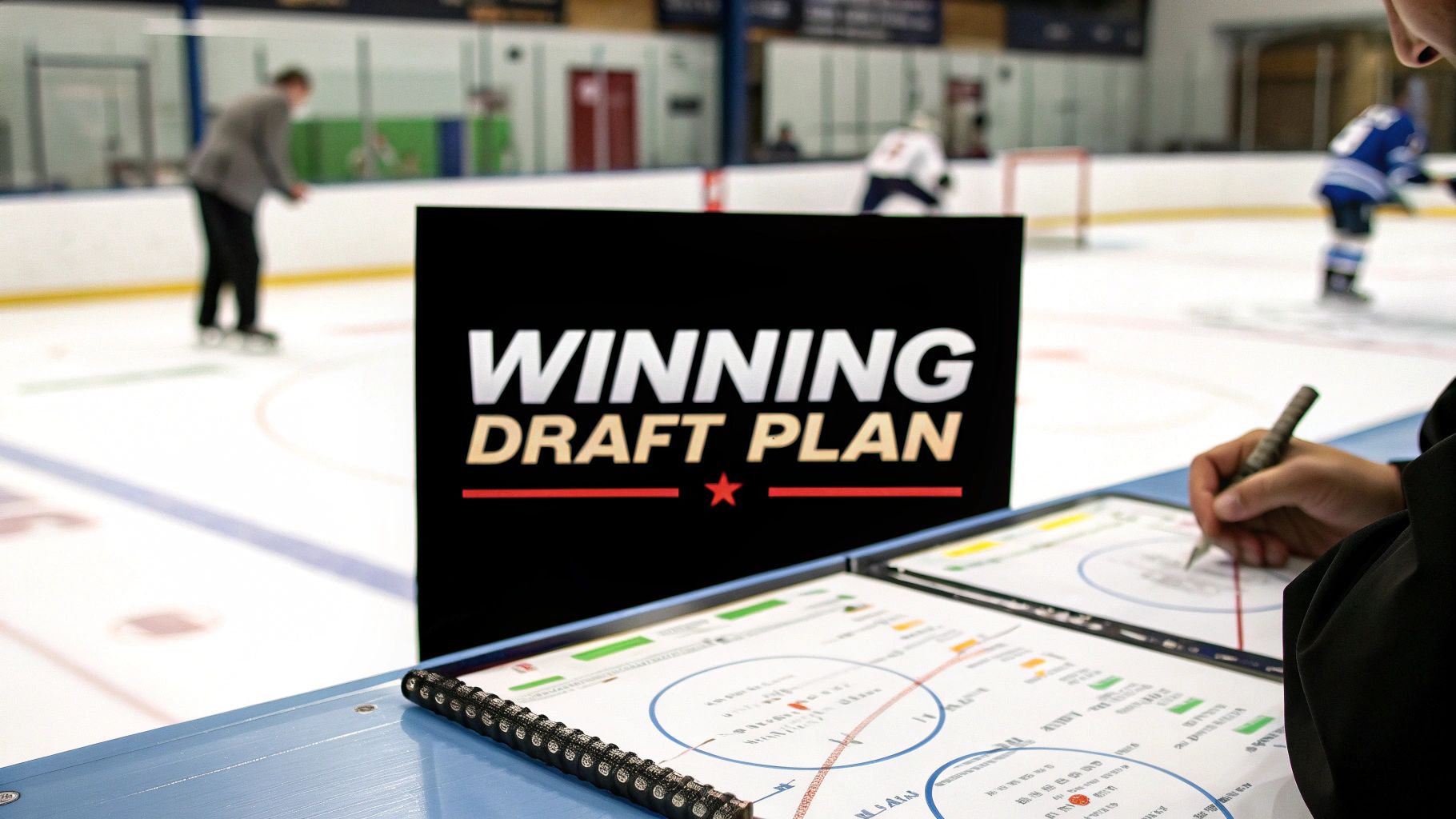
Welcome to your blueprint for fantasy hockey domination. Standard draft guides often repeat generic advice like 'draft the best player available,' but championship-winning seasons are forged from calculated, deliberate plans. This guide moves past surface-level tips to provide actionable frameworks, diving deep into seven advanced fantasy hockey draft strategies you can implement on draft day.
We'll dissect a range of proven approaches, from the high-risk, high-reward "Stars and Scrubs" model to the steady consistency of "Balanced Roster Construction." You will learn how to weaponize positional scarcity, build a team laser-focused on specific categories, and identify undervalued assets using data-driven methods. This isn't just theory; each strategy is broken down with clear pros, cons, and practical examples to guide your decision-making process.
Furthermore, we'll demonstrate how to integrate powerful resources, like PuckNStick’s player analytics, to give you a definitive edge over your league mates. Whether you're a seasoned manager in a highly competitive league or just looking to secure bragging rights amongst friends, mastering these concepts will transform your draft from a game of chance into an exercise in tactical precision. Prepare to build a roster that's not just competitive, but meticulously engineered to win.
1. Stars and Scrubs Strategy
The "Stars and Scrubs" approach is a high-risk, high-reward fantasy hockey draft strategy that polarises your draft capital. Instead of building a balanced roster, you focus on securing a few elite, game-changing superstars in the early rounds. The remainder of your roster is then filled with late-round sleepers, undervalued veterans, and high-upside prospects, colloquially known as "scrubs." The core belief is that your stars' dominant production can carry your team, winning you multiple categories each week and outweighing the potential inconsistencies of your later picks.
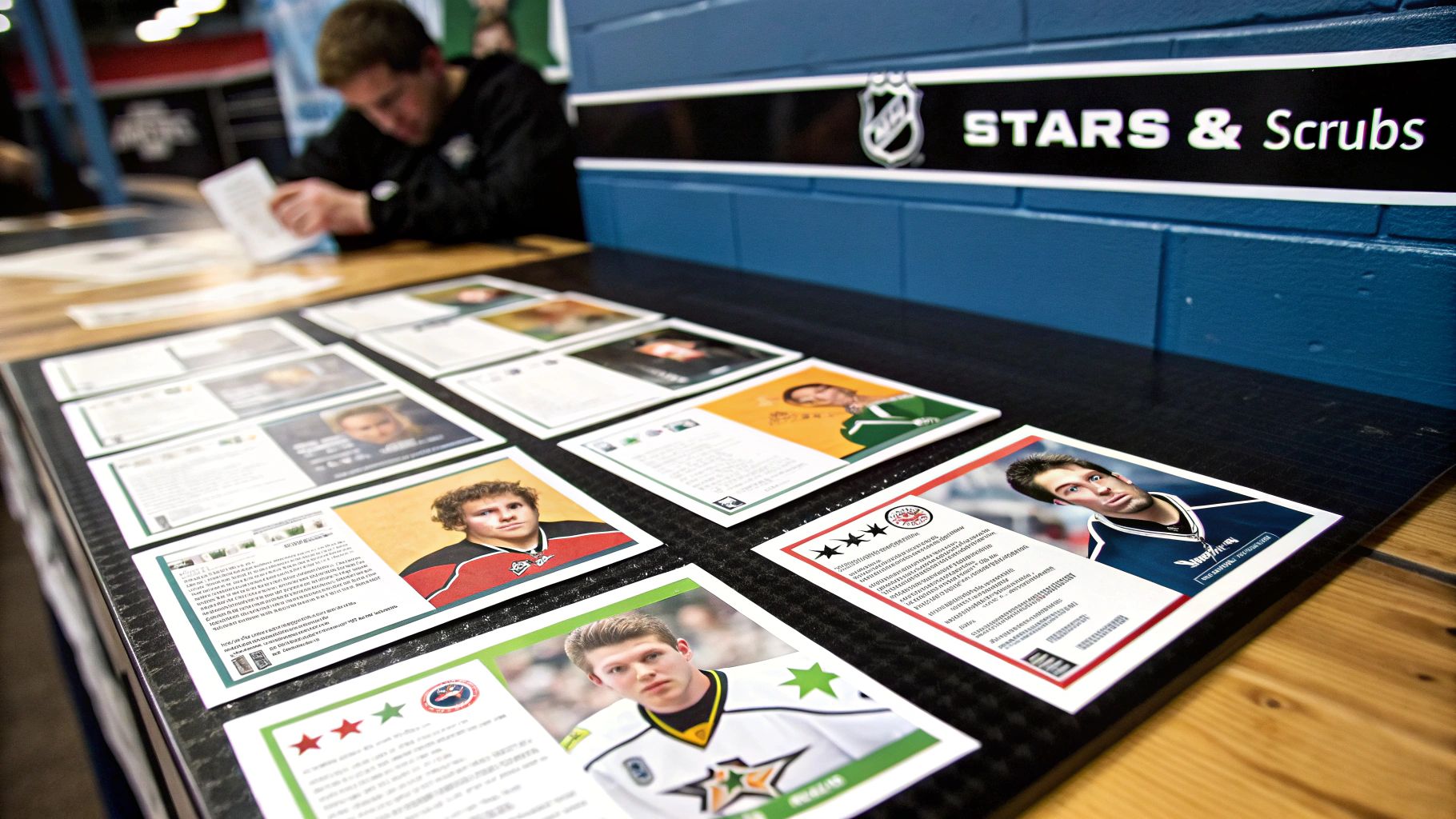
This strategy hinges on your ability to identify true value in the later rounds. It’s not just about picking random players; it's about pinpointing individuals poised for a breakout or those in situations that could lead to increased ice time and offensive deployment. Executing this requires deep research and a strong conviction in your scouting abilities.
How to Implement This Strategy
To successfully employ the Stars and Scrubs method, you must be aggressive early. For example, in a snake draft, you might use your first two picks on a dominant forward like Nathan MacKinnon and an elite offensive defenceman like Cale Makar. You're sacrificing mid-round stability for top-tier production that few other teams will possess.
Your later rounds then become a hunt for value. You'd target players like rookie Connor Bedard, who has immense upside, or a veteran like Brayden Point, who may have slipped due to a down year but still plays in an elite offensive system. For goaltending, you might grab a top-five goalie like Ilya Sorokin and then punt your second goalie pick until the very end, hoping to land a backup with starter potential, such as Ukko-Pekka Luukkonen.
PuckNStick Pro Tip: The key to this strategy is quantifying the advantage your stars provide. Use PuckNStick’s Player Comparison Tool to measure the statistical gap between an elite player like Connor McDavid and a replacement-level forward you could get from the waiver wire. Seeing that massive differential in points, shots, and power-play points will reinforce why concentrating your draft capital is a viable path to victory.
Actionable Tips for Success
- Scrutinise Injury Histories: Your entire strategy rests on your stars staying healthy. Thoroughly research the injury history of your early-round targets before committing to them.
- Target Opportunity: In late rounds, focus on players set for expanded roles. Look for young players ascending to a team's top power-play unit or filling a void left by a departed veteran.
- Monitor Pre-Season News: Training camp reports and pre-season line combinations are your best friends. A previously unheralded player skating on the top line with a superstar becomes a prime "scrub" target.
- Have a Contingency Plan: Because this strategy is so top-heavy, an injury to a star can be devastating. Keep a close eye on the waiver wire for emerging talent and be ready to act quickly to mitigate the damage.
2. Balanced Roster Construction
The "Balanced Roster Construction" strategy is the antithesis of the high-risk Stars and Scrubs approach. This method prioritizes stability, depth, and consistency across your entire lineup. Instead of concentrating draft capital on a few elite players, you aim to build a team with no discernible weaknesses, rostering reliable, high-floor players in every round who contribute across multiple statistical categories. The goal is to create a roster that can win a matchup even if one or two players have an off-week.
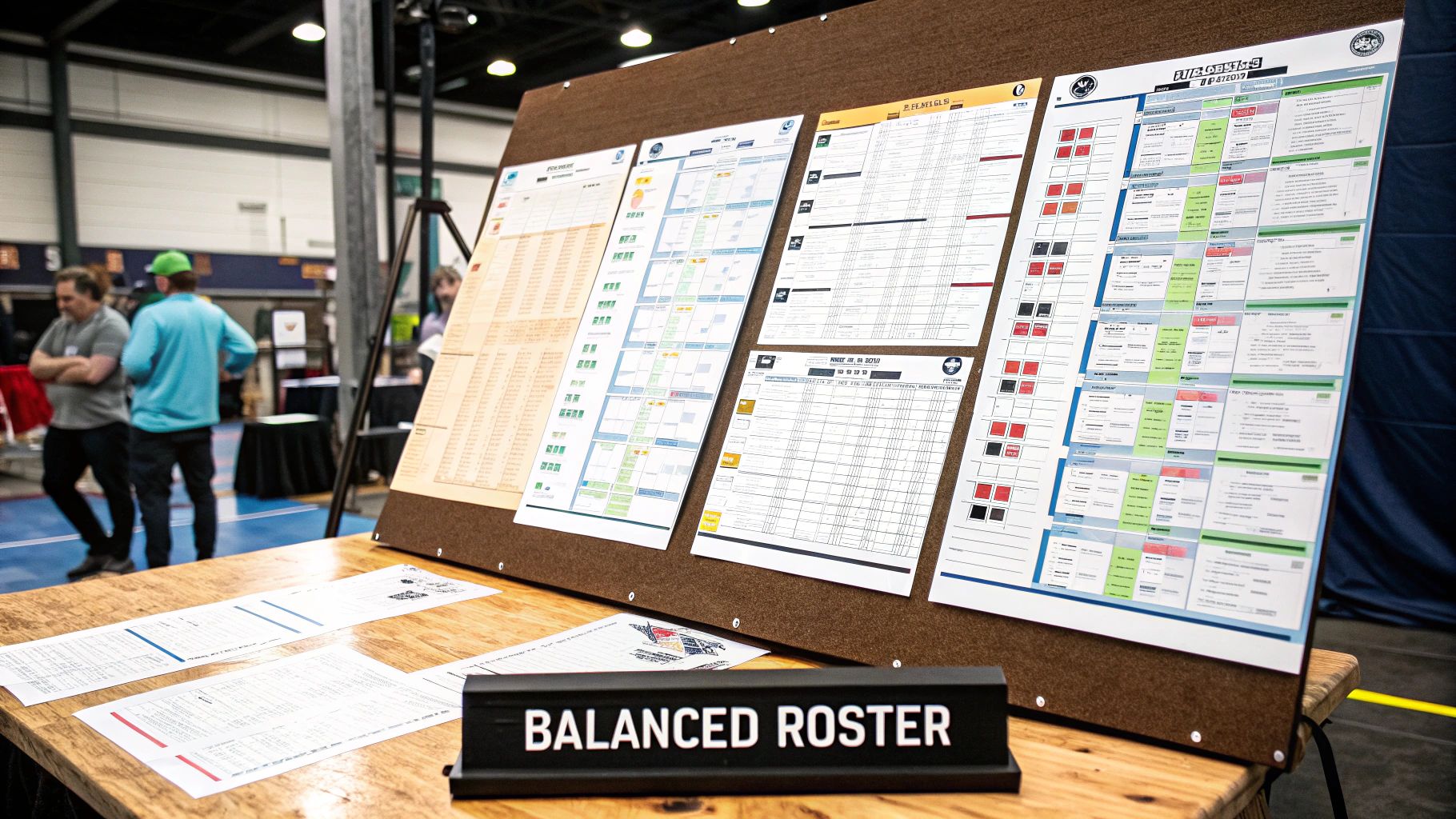
This is one of the most reliable fantasy hockey draft strategies, particularly for managers in highly competitive leagues or those who prefer a less volatile, week-to-week experience. It relies on drafting players with a proven track record of production and avoiding those with significant question marks, such as unproven rookies or veterans coming off unsustainable career years. Your team may lack the explosive single-week ceiling of a Stars and Scrubs roster, but it will possess a higher floor and greater resilience against injuries or slumps.
How to Implement This Strategy
A balanced approach means you're looking for value in every round, not just the early and late ones. In the first few rounds, you would target top-tier players known for their consistent, multi-category contributions. For example, you might select a forward like Mika Zibanejad or Elias Pettersson, who consistently produce around a point-per-game, rather than gambling on a player with a wider range of outcomes.
In the mid-rounds, you continue to build out your core. You would look for dependable defencemen like Roman Josi or Miro Heiskanen, who deliver points, power-play production, shots, and blocks. The key is to avoid reaching for single-category specialists. For your goaltenders, you would aim for two solid, top-15 options rather than one superstar and one afterthought, ensuring stability in the crease. This strategy creates a deep roster that is difficult to play against and provides you with valuable trade assets. You can use a fantasy hockey trade analyzer to evaluate deals later in the season to further optimize your well-rounded team.
PuckNStick Pro Tip: A balanced roster thrives on accumulated value. Use PuckNStick's Draft Day Dashboard to track positional runs and identify players who have fallen below their average draft position (ADP). Snagging a player like Mark Scheifele a round later than expected provides a massive boost to this strategy, as it's built on securing consistent producers at a good price.
Actionable Tips for Success
- Target Proven Production: Prioritize players with at least three years of consistent, predictable performance. Their established track record is a more reliable indicator of future success.
- Avoid Chasing Career Years: Be cautious of drafting players coming off a massive, outlier season. They are often overdrafted the following year and are prime candidates for statistical regression.
- Analyse Ice Time: Focus on players who receive significant even-strength and power-play ice time. Consistent deployment in key situations is the foundation of steady fantasy production.
- Value Multi-Category Defencemen: Blueliners who contribute points, shots, blocks, and hits are the backbone of a balanced team. They provide a high floor and help you win multiple categories each week.
3. Position Scarcity Approach
The Position Scarcity Approach is a calculated fantasy hockey draft strategy that prioritises positions where elite, difference-making talent is in short supply. Instead of simply drafting the best player available, you focus on securing top-tier talent at positions like defence and goaltending early, recognizing that the drop-off in production at these spots is much steeper than at forward. The fundamental principle is that a reliable, high-scoring defenceman or a workhorse starting goalie offers a greater competitive advantage than a forward of equivalent draft value, because quality replacements are harder to find.
This strategy is built on understanding supply and demand within the fantasy draft pool. While you can find serviceable wingers and centres in the middle to late rounds, the pool of defencemen who can quarterback a power play and consistently produce points, or goalies who provide elite ratios and a high volume of starts, dries up very quickly. Committing early picks to these scarce positions can create a foundational advantage that is difficult for competitors to overcome.
How to Implement This Strategy
To execute the Position Scarcity Approach, you must be willing to pass on high-scoring forwards in the early rounds in favour of an anchor on defence or in net. For instance, after securing a top forward in the first round, you might use your second-round pick on an elite defenceman like Cale Makar or Roman Josi. While your opponent might be taking a 90-point winger, you’re locking in 70-plus points and significant power-play production from a position where most teams will struggle to get 40.
Similarly, this strategy often involves targeting a top-five goalie like Igor Shesterkin or Connor Hellebuyck in the second or third round. This secures a massive advantage in goaltending categories, which can be volatile and difficult to manage. You then focus on drafting forwards with your mid-round picks, confident that the depth at those positions will allow you to build a competitive forward corps while your opponents are scrambling to find a viable starting goalie or a number-one defenceman.
PuckNStick Pro Tip: Understanding positional drop-offs is crucial. Use PuckNStick’s Positional Tiers Tool to visualise the talent cliffs. The tool clearly shows how the expected statistical output for defencemen and goalies plummets after the top 10-15 players are off the board, while the forward position maintains a much more gradual decline. This data reinforces why securing an elite D-man or goalie early is one of the most effective fantasy hockey draft strategies.
The infographic below highlights key data points illustrating the scarcity at these critical positions.
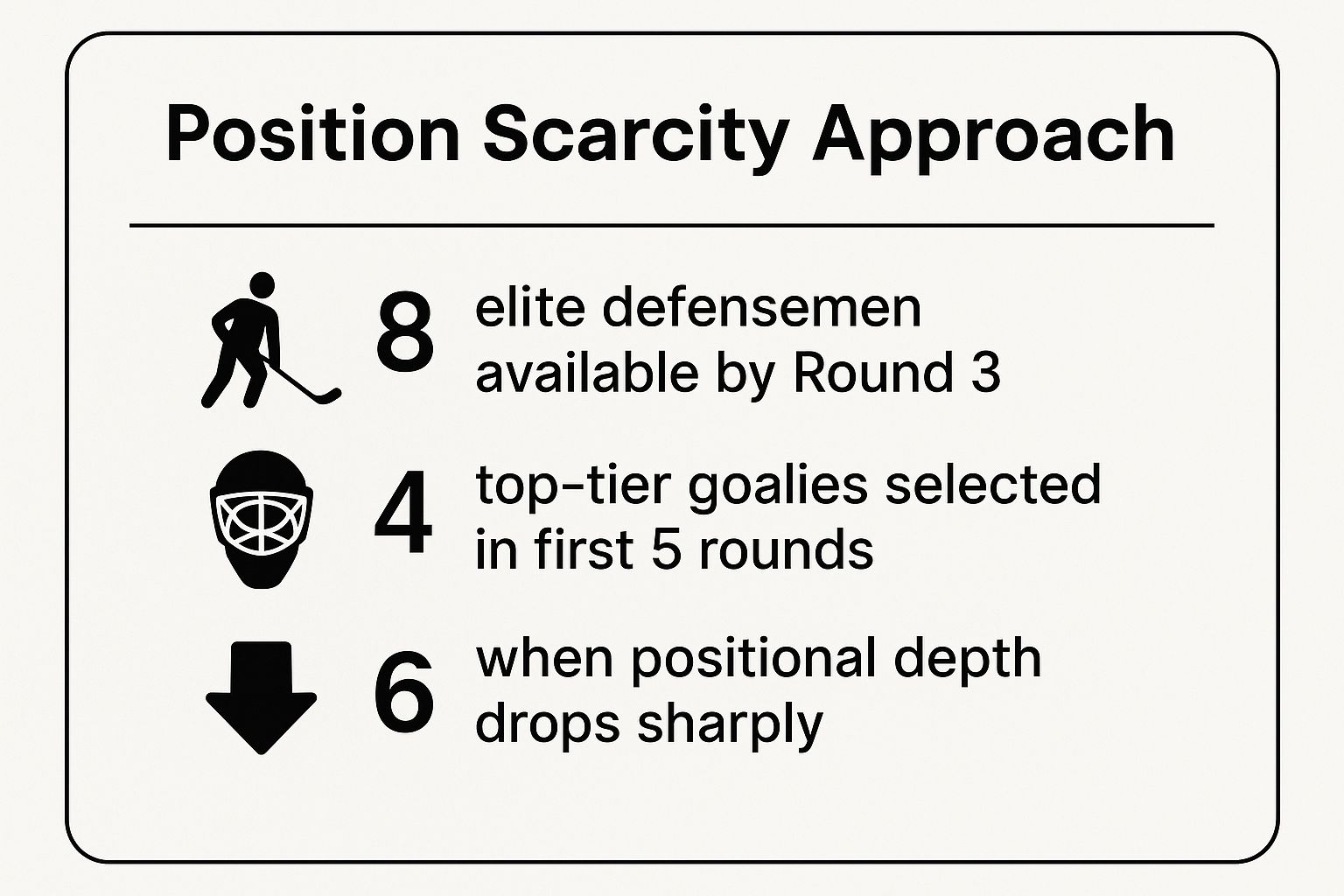
As the data shows, the window to secure game-changing talent at defence and goalie closes rapidly, making early-round investment a sound strategic decision.
Actionable Tips for Success
- Map Out Talent Tiers: Before your draft, create tiers for each position. Identify the significant drop-off points so you know when you absolutely must draft a player at a scarce position.
- Know Your League's Scoring: This strategy is most effective in categories leagues where goalie stats (Wins, GAA, SV%) hold significant weight and leagues that reward defencemen for shots, blocks, and power-play points.
- Don't Neglect Forwards Entirely: While prioritising D and G, ensure you don't fall too far behind at forward. Have a list of high-floor, mid-round forwards to target after you've secured your positional anchors.
- Target Offensive Systems: When drafting a defenceman, prioritise players who are the undisputed top option on their team's first power-play unit, as this is where the majority of their offensive production will come from.
4. Category Specialization
The Category Specialization strategy, often called "punting," is a calculated approach where you deliberately concede certain statistical categories to build an overwhelmingly dominant team in others. Instead of drafting a well-rounded roster that is merely competitive across the board, you focus your draft capital on acquiring players who excel in a select group of categories, aiming to win those matchups decisively every week. The core idea is that winning five categories 5-0 is just as effective as winning them 5-4, but it's often easier to achieve by ignoring stats you deem less important or too volatile.
This is one of the most analytical fantasy hockey draft strategies, requiring a deep understanding of your league’s scoring system and player values. By punting categories like penalty minutes (PIM) or plus/minus (+/-), you can bypass players who derive much of their value from these stats and instead target elite offensive specialists who might otherwise be drafted higher. It's a game of targeted strengths versus accepted weaknesses.
How to Implement This Strategy
To execute this strategy, you must first analyse your league’s categories and decide which ones to punt. Common choices are volatile or specialist stats like PIM, blocked shots, or even goalie categories if you choose an all-out offensive assault. For example, in a standard 10-category head-to-head league, you might decide to punt PIM, hits, and blocked shots.
With this plan, you would ignore tough players like Radko Gudas or Brady Tkachuk (despite his offensive skill, his PIM value is part of his high draft cost) and instead focus solely on pure point-producers and power-play specialists. Your draft board would prioritise players like Elias Pettersson, William Nylander, and Quinn Hughes, who provide elite numbers in goals, assists, shots, and power-play points without contributing much in the punted categories. This allows you to build a team that is nearly unbeatable in the offensive metrics you've chosen to dominate.
PuckNStick Pro Tip: Before your draft, use PuckNStick’s League Analyser Tool to review historical data from your league. The tool can show you which categories are the most volatile week-to-week and which ones require the most draft capital to win consistently. Identifying that PIMs or shutouts are unpredictable can give you the confidence to punt them and reallocate your resources to more stable categories like shots on goal or power-play points.
Actionable Tips for Success
- Commit to Your Punt: Once you decide which categories to ignore, stick to your plan. Don't be tempted by a player who falls in the draft if their primary value lies in a category you are punting. Consistency is key.
- Target Multi-Category Specialists: Within your chosen categories, look for players who contribute to several of them. A forward who scores goals, racks up power-play points, and shoots a high volume is more valuable than a one-dimensional goal scorer.
- Understand Player Pools: Know which players become more valuable in your specialised build. For instance, if you punt hits and blocks, skilled offensive defencemen like Rasmus Dahlin or Roman Josi skyrocket in value compared to their usual rankings.
- Play the Waiver Wire Smartly: Your strategy extends beyond the draft. Use the waiver wire to stream players who can provide a specific boost in a target category for a given week, ensuring you maintain your dominance where it counts.
5. Youth Movement Strategy
The "Youth Movement Strategy" is an approach that prioritises potential and upside over proven, veteran production. Instead of drafting players at their statistical peak, you target young, emerging talent who are poised for a significant leap in performance. This fantasy hockey draft strategy involves drafting players typically 23 years old or younger who are stepping into expanded roles, have elite prospect pedigrees, or have already shown flashes of top-tier talent. The goal is to build a roster that gets stronger as the season progresses, catching your league-mates by surprise with breakout performances.
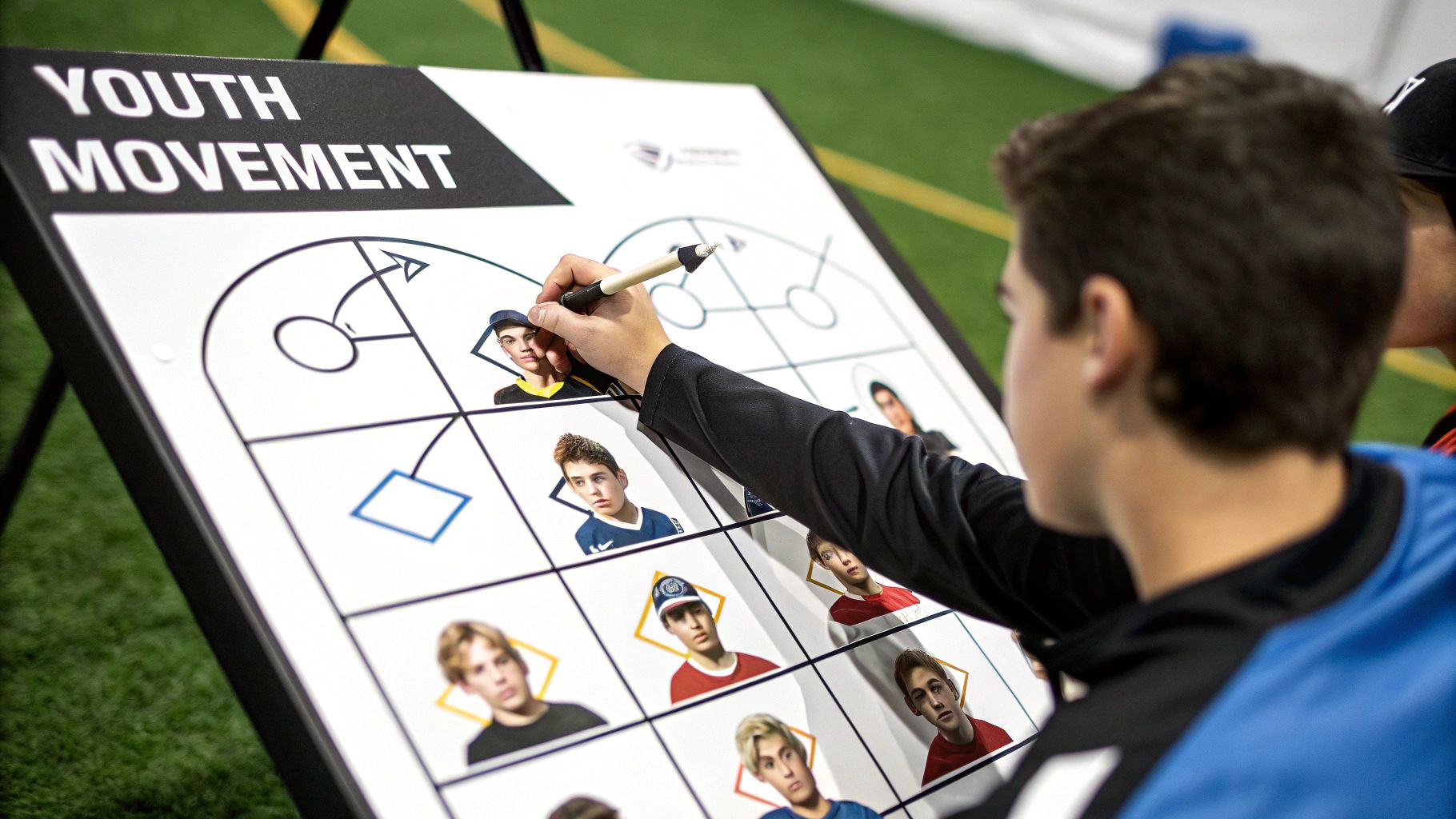
This strategy requires a good understanding of prospect development and organisational depth charts. Success hinges on correctly identifying which young players have the talent and, just as importantly, the opportunity to succeed. While rostering established 70-point veterans offers a safe floor, hitting on a player like Tim Stutzle or Jack Hughes right before they explode for a 90-plus point season can single-handedly win you a fantasy championship.
How to Implement This Strategy
To execute the Youth Movement Strategy, you must be willing to accept some risk in the mid-rounds. After securing a foundational star or two, you begin targeting high-upside youngsters instead of safer, lower-ceiling veterans. For example, you might draft a promising forward like Lucas Raymond or Moritz Seider a round or two earlier than their average draft position (ADP), betting on their breakout potential.
In later rounds, this strategy continues with targeting rookie goalies with a path to the starting job, such as Pyotr Kochetkov, or second-year players who finished their rookie campaigns strong. The key is to build a portfolio of young assets. Not all of them will hit, but the ones who do will provide a massive return on investment, as you will have acquired star-level production from a mid-round draft pick. This approach can be particularly effective in keeper or dynasty leagues where long-term value is paramount.
PuckNStick Pro Tip: Projecting a young player's role is critical to this strategy. Use PuckNStick's Line Combination Tool to analyse pre-season and early-season deployments. Seeing that a sophomore player is consistently skating on the top power-play unit is a clear indicator of the team's confidence in them and a strong signal for a potential breakout, justifying the draft-day risk.
Actionable Tips for Success
- Assess the Opportunity: Talent isn't enough; young players need ice time. Research team depth charts to see who has a clear path to top-six forward minutes or a spot on the top power-play unit.
- Target Power-Play Roles: A significant portion of offensive production comes with the man advantage. Prioritise young players who are already established on their team’s top power-play unit or are next in line.
- Don't Forget Sophomore Leaps: Often, the biggest developmental jump comes between a player's first and second season. Target players who had strong rookie years, as they are often primed for even greater success. Identifying these players is a core part of finding excellent fantasy hockey sleeper picks.
- Balance with a Few Veterans: To mitigate the inherent risk, it's wise to anchor your roster of young guns with a couple of high-floor, reliable veterans. This provides a safety net in case some of your breakout candidates take longer to develop than anticipated.
6. Goalie Streaming Strategy
The Goalie Streaming Strategy is a value-based approach that consciously de-prioritises the goaltender position during the draft. Instead of spending high-value early or mid-round picks on elite netminders, you deliberately punt the position, opting to fill your goalie slots with late-round tandem goalies, backups, or lower-tier starters. The saved draft capital is then reallocated to bolster your skater positions, loading up on high-volume shooters and point producers. Your weekly goaltending success then relies on actively managing the waiver wire, "streaming" goalies based on favourable matchups and team schedules.
This is one of the more active in-season fantasy hockey draft strategies, as it turns your goalie slots into a revolving door. The core principle is that the production from one or two extra elite skaters provides a more significant and consistent advantage across multiple categories than a single elite goalie might. It capitalises on the inherent volatility of the goaltending position, where even top-tier goalies can have off-weeks, and lesser-known backups can steal wins against weak opponents.
How to Implement This Strategy
To execute this strategy, you must be comfortable ignoring the early and mid-round goalie runs. While other managers are drafting Andrei Vasilevskiy or Igor Shesterkin, you're grabbing a top-end forward or defenceman. In the later rounds, you'll target goalies in tandem situations, like Tristan Jarry and Alex Nedeljkovic in Pittsburgh, or a solid backup on a great team who is guaranteed to get starts, like Anthony Stolarz in Florida.
Your focus throughout the season shifts to weekly schedule analysis. For example, you might see the Arizona Coyotes are playing the San Jose Sharks on a Tuesday. You would then pick up the Coyotes' starting goalie for that night, benefit from the high-probability win and strong save percentage, and then drop them for another goalie with a favourable matchup later in the week. This active management allows you to piece together strong weekly goaltending numbers without the initial draft investment.
PuckNStick Pro Tip: Effective streaming is all about matchup data. Use the PuckNStick Team Stats Dashboard to identify teams that give up a high volume of shots but have a low shooting percentage. Target goalies playing against these teams; they offer the highest potential for a high save count and a likely win, maximising your streaming value for that night.
Actionable Tips for Success
- Scrutinise NHL Schedules: Weekly and daily schedules are your lifeblood. Look for teams with four-game weeks or multiple games against bottom-tier offensive clubs to identify your prime streaming targets.
- Target Backups on Elite Teams: A backup goalie on a defensively sound, high-scoring team is a streaming goldmine. When they get a spot start against a weaker opponent, they have a very high chance of securing a win.
- Research Defensive Metrics: Don't just look at a goalie's personal stats; analyse their team's defensive capabilities. A goalie on a team that suppresses shots and blocks pucks is a safer streaming option, even if they aren't a household name.
- Maintain a Watchlist: Keep a running list of 3-5 potential streaming candidates on your league's waiver wire. This allows you to pivot quickly when a starter is announced or an injury occurs, ensuring you're never left without an option.
7. Power-Play Specialists Focus
The "Power-Play Specialists Focus" is a fantasy hockey draft strategy that deliberately prioritises players who log significant minutes on their team's top power-play unit. This approach operates on the principle that special teams production, particularly power-play points (PPP), is a fantasy category that can be systematically targeted and dominated. Managers using this strategy often value a player's power-play role as highly, if not more so, than their even-strength output, understanding that man-advantage situations are a primary source of elite offensive production.
This method requires a shift in player evaluation. Instead of just looking at total points, you analyse how those points are generated. A player who scores 60 points with 30 coming on the power play can be more valuable in many fantasy formats than a 70-point player who primarily scores at even strength. Winning the PPP category consistently can provide a significant weekly advantage and is a key component of this drafting philosophy.
How to Implement This Strategy
Executing this strategy means adjusting your draft board to elevate players in prime power-play roles. For example, you might target a defenceman like Quinn Hughes or Erik Karlsson earlier than their overall rankings suggest because they quarterback elite power-play units and accumulate a massive percentage of their points with the man advantage. They become cornerstones of your special teams dominance.
In the mid-to-late rounds, you would continue this focus by targeting forwards who may not be first-line players at even strength but are fixtures on their team's top power-play unit. A player like Brayden Schenn or Sam Reinhart often sees their fantasy value skyrocket due to their net-front presence or bumper role on a potent power play, even if their 5-on-5 ice time is less impressive. The goal is to build a roster where, at any given time, multiple players are on the ice for a high-octane power play.
PuckNStick Pro Tip: The effectiveness of a power-play unit is a major factor. Use PuckNStick’s comprehensive NHL special teams rankings to identify which teams have the most lethal power plays. Targeting players from top-10 units maximises your chances of drafting consistent PPP contributors and gives you a data-driven edge over your league mates.
Actionable Tips for Success
- Research Coaching Tendencies: Some coaches favour a static top unit that gets almost all the power-play time, while others use a more balanced 1A/1B approach. Target players on teams where the coach heavily relies on their primary unit.
- Monitor Pre-Season Alignments: Training camp is the best time to see who is getting a look on the top power play. A mid-tier player suddenly practising with a team's top stars on PP1 becomes an immediate high-value target.
- Analyse Team Penalty-Drawing Rates: Look for players on teams that are adept at drawing penalties. More power-play opportunities directly translate to more chances for your specialists to produce points.
- Don't Neglect Other Categories: While focusing on PPP is key, ensure your roster remains competitive in other areas like shots, hits, or plus/minus. A lopsided team can be exploited, so find specialists who contribute elsewhere too.
Fantasy Hockey Draft Strategies Comparison
| Strategy | Implementation Complexity 🔄 | Resource Requirements ⚡ | Expected Outcomes 📊 | Ideal Use Cases 💡 | Key Advantages ⭐ |
|---|---|---|---|---|---|
| Stars and Scrubs Strategy | Medium-High; requires late-round scouting 🔄🔄 | High early investment in stars, low late-round 🔄⚡ | Elite category dominance from stars, breakout upside 📊⭐ | Leagues valuing top talent, dominant category creators 💡 | Secures elite production, high upside late picks ⭐ |
| Balanced Roster Construction | Moderate; steady drafting across positions 🔄 | Even resource spread across roster 🔄⚡ | Consistent, reliable production across categories 📊 | Balanced scoring leagues, steady-season focus 💡 | Reduces volatility, easier roster management ⭐ |
| Position Scarcity Approach | High; requires deep positional knowledge 🔄🔄 | Early investment in scarce elite positions 🔄 | Positional dominance, leveraging scarcity 📊 | Leagues with scarce elite goalies/defensemen 💡 | Gains unique category advantages, positional stability ⭐ |
| Category Specialization | Moderate; focused drafting by category 🔄 | Targeted player selection per chosen categories ⚡ | Dominates specific categories, punts others 📊 | Leagues allowing category punting, clear drafting strategy 💡 | Easier category domination, accesses undervalued players ⭐ |
| Youth Movement Strategy | Moderate; requires prospect evaluation 🔄 | Focus on young talent with upside 🔄⚡ | High ceiling breakout potential, exciting roster 📊 | Dynasty/redraft leagues valuing youth potential 💡 | High upside, often undervalued players ⭐ |
| Goalie Streaming Strategy | High; demands ongoing waiver activity 🔄🔄 | Minimal goalie investment; active streaming ⚡ | Flexible goalie management, capitalization on matchups 📊 | Leagues with active waiver moves, skater-heavy builds 💡 | Maximum skater investment, matchup exploitation ⭐ |
| Power-Play Specialists Focus | Moderate; requires system and role analysis 🔄 | Target players with power-play roles ⚡ | Elevated fantasy production via power-play points 📊 | Leagues where power-play points are valuable 💡 | Predictable value from specialists, often undervalued ⭐ |
Executing Your Winning Strategy
You have now explored a diverse arsenal of fantasy hockey draft strategies, from the high-risk, high-reward 'Stars and Scrubs' approach to the meticulously planned 'Category Specialization' build. We’ve dissected the logic behind targeting scarce positions, the foresight required for a 'Youth Movement' strategy, and the in-season diligence demanded by 'Goalie Streaming'. Each framework offers a unique path to building a competitive roster, but the most critical takeaway is that a blueprint is not a guarantee of success. True fantasy hockey domination lies in the execution.
The draft room is a dynamic environment. Your perfectly crafted plan to secure two elite centremen and a workhorse goalie can be dismantled in a single round by an opponent’s unexpected pick. This is where preparation transforms into improvisation. The ultimate fantasy hockey draft strategy is not about rigidly adhering to one of the methods we've outlined; it's about understanding the principles behind all of them so you can adapt on the fly.
Synthesizing Your Approach for Draft Day Success
The most seasoned fantasy managers rarely commit to a single strategy from the outset. Instead, they enter the draft with a preferred plan but remain agile, ready to pivot based on how the board falls.
- Be a Hybrid Strategist: You might start with a 'Balanced Roster' approach in mind, but if a top-tier defenceman with elite power-play production falls to you two rounds later than expected, you should be prepared to pivot. This might shift your focus towards locking down 'Power-Play Specialists', blending two distinct strategies into one cohesive, high-upside team.
- Know Your League: The viability of any strategy is directly tied to your league's settings. A 'Category Specialization' plan focused on shots and hits is brilliant in a banger league but useless in a points-only format. Likewise, 'Goalie Streaming' is a powerful tool in leagues with a deep waiver wire but a risky gamble in 14-team leagues where quality goaltenders are scarce.
- Master the Art of the Pivot: Imagine you're aiming for a 'Stars and Scrubs' build, targeting an elite forward duo in the first two rounds. If your primary targets are gone and the best available players are all high-floor, second-tier wingers, forcing your original plan is a mistake. The savvy move is to pivot to a 'Balanced Roster' construction, scooping up that value and building a team with depth rather than top-heavy star power. This adaptability is what separates the champions from the mid-pack finishers.
The Final Puck Drop: From Strategy to Victory
Ultimately, the best fantasy hockey draft strategies are those informed by data, guided by a clear plan, and executed with the flexibility to react to unforeseen opportunities and challenges. Your draft is not just about selecting individual players; it's about constructing a synergistic roster where each piece complements the others to maximise your weekly scoring potential. You are the general manager, and every pick is a calculated move toward building a championship-calibre organisation.
Think of these strategies as your playbook. You won't run the same play every time, but knowing them all allows you to call the right one at the right moment. By combining the foundational knowledge of these drafting philosophies with real-time analytics and a keen awareness of your league's dynamics, you position yourself not just to compete, but to dominate. Now, take these insights, fire up your draft queue, and build the team that will have your leaguemates dreading your matchup all season long.
Ready to turn these strategies into a championship reality? The key to executing any of these fantasy hockey draft strategies is having elite, real-time data at your fingertips. PuckNStick provides the advanced analytics, player projections, and draft-day tools you need to make smarter picks and find league-winning value in every round. Visit PuckNStick to get your competitive edge today.
